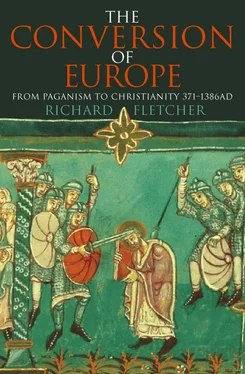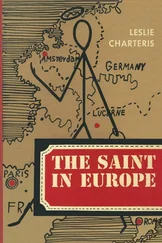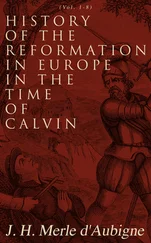The main lines of this account are credible. The commitment of this prominent family to a more intense form of Christian living was likely to have started ripples of influence which perhaps had effects, sadly hidden from us, within the churches which they built. Samson’s string of monastic foundations – and we shall see plenty more examples of such networks – had evangelizing potential. His journeys, foundations and miracles were associated by his biographer with conversion. In Cornwall, for example, in a district referred to as Tricurium, tentatively identified with the area formerly called Trigg in north Cornwall, Samson encountered people worshipping an idol. He admonished them, to little effect. Then it so happened that a boy was killed there in a riding accident. Samson pointed out that their idol could not revive the dead boy but that his God could; and would do so, provided that they promised to destroy their idol and for ever abandon its worship. They agreed to the bargain. Samson prayed for two hours, the boy returned to life, the idol was destroyed, and ‘Count Guedianus’ (? Gwythian) ordered all the people to be baptized by Samson. The holy man stayed in Cornwall for a little while longer, helpfully killing a serpent that was troubling the inhabitants and then founding his monastery, before resuming his journey to Brittany. The author of the Vita Samsonis had been to Cornwall and had seen ‘the sign of the cross which the holy Samson with his own hand had chiselled upon an upright stone’: the Cornish equivalent, we might think, of the creed written out by the hand of Gregory of Pontus in the cathedral of Neocaesarea. Samson’s travels in Trigg might be compared to Martin’s visit to Levroux.
Our last example takes us back to Gaul. Aredius was a slightly younger contemporary of Samson. A native of Limoges, he was born into a prominent family and as a young man was attached to the court of the Frankish King Theudebert (534–48). He was recruited by Bishop Nicetius of Trier – whom we shall meet again in a later chapter – under whom he studied and received the monastic tonsure. On the death of his father and brother he returned to the Limousin to look after his mother Pelagia, who had been left kinless and unprotected. Aredius dedicated himself and his property to the service of God, enthusiastically assisted by Pelagia. He built churches on his estates and founded a monastery at a place now named after him: Saint-Yrieix, a just recognizable derivative from Aredius, to the south of Limoges. The sick flocked to him and ‘he restored them to health by laying on of hands with the sign of the cross.’ 15
Gregory of Tours, our source for this, was a friend of Aredius and had good reason to be grateful to him. The church of St Martin at Tours was one of the principal beneficiaries of the will jointly made by Aredius and Pelagia in 572. 16 It shows that the family was an extremely wealthy one, owning widespread estates, many of which came into the possession of the church of Tours: a further instance of pious largesse to set beside the examples quoted above of Remigius at Rheims and Bertram at Le Mans. Churches are mentioned at some of the estates. Although we cannot be certain that all of these had been built by Aredius, we can be reasonably sure of it in some instances, for example that of ‘our church dedicated in honour of St Médard [of Soissons] at Exidolium ’, presumably Excideuil in northern Périgord, because Medard had died only some twenty years earlier and Aredius had been involved with the growth of his cult. The will also shows that Aredius and his mother possessed large amounts of ecclesiastical furnishings – embroidered linen and silk textiles (altar frontals, walland door-hangings), silver chalices and patens, and some very exotic items such as ‘the crown with a silver cross, gilded, with precious stones, full of relics of the saints … which crown has hanging from it eight leaves wrought from gold and gems’. It was presumably a votive, hanging crown, perhaps akin to the votive crown of the Spanish king Recesswinth (643–72) found in the treasure of Guarrázar, near Toledo. These textiles and treasures should alert us to the impact which the interiors of these churches might have made upon the senses of those who worshipped in them; a not insignificant element in considering the process of Christianization.
In the middle years of the sixth century John of Ephesus conducted an evangelizing campaign in the provinces of Asia, Caria, Lydia and Phrygia – roughly speaking, today’s western Turkey. In the course of several years’ work he and his helpers demolished temples and shrines, felled sacred trees, baptized 80,000 persons, built ninety-eight churches and founded twelve monasteries. And this was in the heart of the empire, an area where there had been a Christian presence since the time of St Paul, not in some out-of-the-way corner like Cornwall or Galicia. In 598 Pope Gregory wrote to the bishop of Terracina to express dismay at a report that had reached him to the effect that the inhabitants of those parts were worshipping sacred trees. Again, not a remote spot; Terracina is on the coast between Rome and Naples, its countryside traversed by the Via Appia, one of the busiest highways of the Mediterranean world.
These two reports remind us that the conversion and Christianization of the countryside was a very slow business. The point cannot be sufficiently emphasized. The evidence surveyed in this chapter has been largely normative, that is to say it lays out ideals or targets. Our sources speak with the official voice of the educated elite within the church; they do not describe the everyday reality of belief and observance among the laity. That reality will always be elusive. Can we make any assessment at all of what had been achieved? Any answer to this question must be cautious, but need not be blankly negative.
Our two earliest activists, Gregory of Pontus and Martin of Tours, were operating at times when and in places where Christianity had made no impact at all upon the countryside. We may guess that in this respect Pontus and Touraine were not untypical. Two centuries later, in the age of Gregory of Tours and Martin of Braga, conditions had changed. They were operating in a social world which was, in a formal sense, Christian. Paganism as overt, active, public cult no longer existed in Gaul or Spain (except among the Basques). Caesarius of Arles, Martin of Braga, Gregory of Tours, Pope Gregory the Great, had as their principal concern the problem of how to make people who were nominally Christian more thoroughly Christian, the more effectively to guard them from demonic assault which would threaten God’s protection of the whole community. These pastors were clear about the disposition and behaviour required of the good Christian and they did their utmost to set their standards and expectations clearly before the laity. Here, they are saying, is a pattern of godly behaviour to which you must try to conform. This is the message not just of the directly homiletic material (Caesarius, Martin) but also of much of what we are accustomed to think of as the ‘historical’ works of Gregory of Tours. They were also clear about what the good Christian should avoid. All four of these writers would probably have agreed in terming it rusticitas , ‘rusticity’. The notion of rusticity comprehended not just doing a bit of fencing or brushing your hair on a Sunday, not just boorish junketings at the Kalends of January, but potentially also something much more menacing in the guise of resort to alternative systems of explanation, propitiation and control. This is the lesson of the story about Aquilinus and the arioli. There existed an alternative network to the one presented by Christian teachers. There were other persons about, easily resorted to, claiming access to the means of explaining misfortune, curing sickness, stimulating love, wreaking vengeance, foretelling the future, advising when to undertake a journey, interpreting the flight of birds or the patterns on the shoulder-blades of sheep.
Читать дальше












